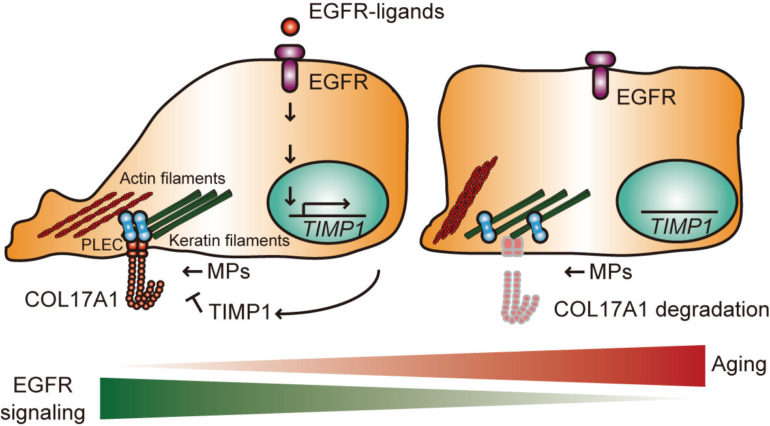Although sometimes hard to accept, with aging, many things in our bodies change. One of these is the ability of the skin to regenerate. Old skin is just not as good as young skin at healing wounds. However, the molecular and cellular mechanisms underlying this are largely unknown. Now, researchers from Japan have identified a mechanism to explain why this happens and potentially how it can be fixed.
In a study published this month in the Journal of Cell Biology, researchers from Tokyo Medical and Dental University (TMDU) have revealed that the ability of skin stem cells to repair skin after an injury may be linked with their ability to move towards the injury.
Skin stem cells, also called keratinocyte stem cells, are responsible for skin regeneration and wound closure through a process called re-epithelialization. “Live-imaging and computer simulation experiments showed that human skin stem cells motility is coupled with their proliferative and regenerative capacity and old stem skin cells have a significantly reduced motility,” explains Daisuke Nanba, lead author of the study.
To understand the mechanisms behind this reduced motility in old stem cells, the researchers compared the wound healing and proliferative ability of skin stem cells derived from young mice (12 weeks old) and aged mice (19-25 months old). The experiments showed that a specific molecule, called EGFR (Epidermal Growth Factor Receptor), drives skin stem cell motility and that EGFR signaling is reduced in old stem cells. EGFR acts by preventing the degradation of a specific type of collagen, COL17A1, which is necessary to hold the layers of the skin together.
Interestingly, COL17A1 coordinates the movement of skin stem cells towards the injury by regulating actin and keratin filament networks in the cells. The researchers found that with age, a decrease in EGFR signaling occurs, leading to lower levels of COL17A1 and skin stem cells with reduced mobility that are less able to re-epithelialize the skin.
With advanced age, a reduced skin wound healing ability is associated with the development of so-called chronic nonhealing disorders, such as diabetic ulcers and pressure sores. “Although further investigations are still required, stabilizing COL17A1 by regulating its proteolysis is a promising therapeutic approach for improving the decline in skin regeneration observed with age that often leads to serious issues such as ulcers,” says Emi Nishimura, senior author on the study. This research sheds further light on the mechanisms underlying wound healing and may lead to the development of new therapeutic treatments to improve skin regenerative capacity.
Hair follicles heal blisters at personal cost
More information:
Daisuke Nanba et al, EGFR-mediated epidermal stem cell motility drives skin regeneration through COL17A1 proteolysis, Journal of Cell Biology (2021). DOI: 10.1083/jcb.202012073
Provided by
Tokyo Medical and Dental University
Citation:
Skin stem cells get moving for enhanced skin regeneration (2021, October 15)
retrieved 17 October 2021
from https://medicalxpress.com/news/2021-10-skin-stem-cells-regeneration.html
This document is subject to copyright. Apart from any fair dealing for the purpose of private study or research, no
part may be reproduced without the written permission. The content is provided for information purposes only.



